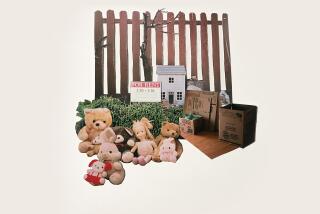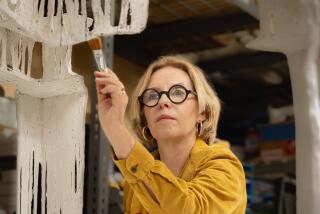A Bond With Those Who Come After Us
- Share via
When we first moved into our turn-of-the-century house--my first house, actually--and started the endless process of getting it into shape, it was discouraging to discover that while the original structure was remarkably solid and well-built, most of what had been changed or added over the years had been done poorly.
Bad plumbing, shoddy electrical work and careless carpentry greeted us at every turn. In most instances cheap materials had been used, and fixtures improperly installed.
I remember the day that water started flowing from the kitchen ceiling. We weren’t certain which fixture upstairs was responsible until one day a guest took a fragrant-pine bath.
As I watched the green water dripping into a bowl on my kitchen counter, and smelled the pine mingling with the garlic and herbs in my potage as it simmered on the stove, I wondered what sort of horror we were about to uncover. How could the bathtub be draining into the kitchen?
The explanation was quite simple: the trap had been improperly located under the tub. It had rotted out and needed to be replaced. But to reach it, half the bathroom and a chunk of the kitchen ceiling had to be torn out.
Why Did They Skimp?
We decided that we might as well have the entire bathroom remodeled. As we began to plan for this work, we again asked ourselves the question we had already asked so often:
Why wasn’t the effort made to do the job properly at the beginning?
One probable answer was that doing the job right would have required additional outlays of time and money. And if the quality of the work in the house had been adequate for the lifetime of the people who had done the work, why should they have bothered with additional time and cost?
As we gradually transformed our home over 10 years, the question of how the work should be done arose over and over. Each time we had to make a decision, we faced the same issue:
How far beyond our own life span--or house span--should we be thinking?
It would have been easier not to think about what we would be leaving behind for the people coming after us. But our own frustration at what we were finding made us determined to do everything the best way we could and to spend some extra money, if need be, to give our unknown friends-of-the-future something of value to work with, and work in.
We also took stock of our landscaping attitudes.
Slow-Growing Trees
I had wanted to plant fast-growing trees and shrubs, although I knew that the faster they grow, the shorter their life span. I was thinking only of myself. They certainly would have lasted long enough to give me pleasure.
It took some reassessing of my own values before I saw the importance of planting slow-growing trees. Now I love the idea. And when I walk around my suburban neighborhood, I think often of my debt to those who, long ago, planted the majestic, slow-growing trees whose branches are like arms of friendship reaching across the generations.
A few years ago, I asked myself why people should want to think of, or live for, those coming after them. I wondered what would persuade someone to do this. I asked myself how I would define the feelings I have now that make me want to do it.
Implausible as it may seem, I think it is the feeling of “parenting.”
When people have children, they always want to build for the children’s future. They save and plan and do all in their power to make sure that their children are provided for. They care for their worldly goods so that they can pass them on intact, they care for the wisdom of generations so that their children will not forget.
They Will Inherit
They do this because they love their children, and it is in the nature of love to stretch and transcend limits. I think that those who come after us are, in a very real sense, our children.
Generations of human beings and creatures who have not yet made their appearance in the world will be inheriting from us. So clearly, the edge of the family circle can’t be defined by time and space. Its circumference transcends all boundaries of past and future.
We are so deeply indebted to past generations that we can’t afford not to be deeply aware of those coming along after us. How much do we love them, what are we leaving them? Are we building the “house” well?
Having said all this, there is one thing we did to our house that may, I fear, never be forgiven. We took up the oak floor in the hall and dining room in order to lay a classic, English-style black-and-white checkerboard floor.
“I can see them now,” I said to my husband, “standing here wringing their hands, moaning about how nobody in his right mind would rip our oak flooring to lay vinyl. Maybe we shouldn’t do it.”
Placed a Letter
John reminded me that this was our house, our work of art. And I reminded myself of the difference between technical excellence and original style--reminded myself that one of the most vital ideas we can ever pass to our “children” is that of the sanctity of the individual.
Nevertheless, when the installer came to lay the tiles, I gave him an envelope, and he obediently inserted it under one of the tiles in the dining room. It is a letter addressed to whomever tears out the black-and-white floor.
It is both a greeting and an apology from their friends from the past, begging their indulgence for our one greatest liberty with “their” house. And expressing regret that they obviously hadn’t liked what we had done.
But at least they will know we were thinking of them, and that we cared.


